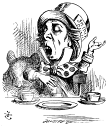Search us!
Search The Word Detective and our family of websites:
This is the easiest way to find a column on a particular word or phrase.
To search for a specific phrase, put it between quotation marks. (note: JavaScript must be turned on in your browser to view results.)
Ask a Question! Puzzled by Posh?
Confounded by Cattycorner?
Baffled by Balderdash?
Flummoxed by Flabbergast?
Perplexed by Pandemonium?
Nonplussed by... Nonplussed?
Annoyed by Alliteration?

Don't be shy!
Send in your question!
Columns from 1995 to 2006 are slowly being added to the above archives. For the moment, they can best be found by using the Search box at the top of this column.
 If you would like to be notified when each monthly update is posted here, sign up for our free email notification list.
If you would like to be notified when each monthly update is posted here, sign up for our free email notification list.
Trivia
All contents herein (except the illustrations, which are in the public domain) are Copyright © 1995-2020 Evan Morris & Kathy Wollard. Reproduction without written permission is prohibited, with the exception that teachers in public schools may duplicate and distribute the material here for classroom use.
Any typos found are yours to keep.
And remember, kids,
Semper Ubi Sub Ubi
|
Squeeze play.
Dear Word Detective: Found your column on “gams” and “door jambs,” but it didn’t speak to the many-faceted “jam/jamb.” Is a traffic “jamb/jam” related to the door or the jelly? Is something “jambed up” or “jammed up”? What does a musical “jam session” have to do with either the door jamb or the jelly-jam (if anything?) Are the various “jamb/jams” from the same root or do they have different variations? Please help as I’m stuck — or all jammed up. — Barney Johnson.
This question is making me hungry, probably because I eat a lot of peanut butter and jelly sandwiches (though usually with jam or preserves), often for breakfast. Hey, it beats microwave pancakes, and no, I cannot cook “real food” when I’m asleep. But how come a teeny-tiny jar of raspberry preserves now costs $4.50? It’s not even organic! And it’s probably 50% high-fructose corn syrup! (Excuse me, the TV says we’re supposed to call that “corn sugar” now. Yum!) And I’m running out of exclamation points! Anyway, it’s an outrage, so please write your local politician. And while you’re at it, tell those darn kids to get off my lawn.
That’s a rather tangled web you’ve woven in your question, so I’m going to jump to the finish line right now, which should help untie a few knots. No, there is no connection between “gams” (slang for legs) and “jamb” (door frame) on the one hand, and the various permutations of “jam” (traffic, musical, jelly-jam, etc.) on the other.
As I said in that column a couple of years ago, “gams” as slang for a woman’s legs dates back to the late 18th century, when it applied to the legs of either sex. The root of “gam” may be the Italian “gamba,” also meaning “leg,” but it may also have come from a close cousin of “gamba,” the French “gambe” or “jambe,” which gave us the “jamb” found in “door jamb,” the side pieces of a door frame. This “jamb” is so-called because it is the “legs” which support the frame.
“Jam” first appeared in the early 18th century as a transitive verb meaning “to press or squeeze something” or “to wedge or immobilize something in an opening” (“The Ship … stuck fast, jaum’d in between two Rocks,” Defoe, Robinson Crusoe, 1719). The origin of “jam” is a bit hazy; the Oxford English Dictionary (OED) labels it “apparently onomatopoeic” and suggests it might be a variant of the verb “to champ,” meaning “to chew or bite” (as a horse noisily “champs” on its bit when excited or impatient). So “jam” was intended to be evocative of the sound, sight or feeling of something being forced into a tight spot.
“Jam” as a verb went on to mean “to block or obstruct” (eventually producing the “jamming” that can block radio signals) and, as an intransitive verb, meaning “to become immovable or unworkable by wedging or sticking” as a gun may “jam.” As a noun, “jam” developed a variety of meanings, most of them involving either the act of “jamming” or the result of “jamming,” as in a “traffic jam” or, in a figurative sense, “jam” meaning a difficult situation (“I’m in a jam. But I’m not going to the cleaners… Half of this money is mine,” Raymond Chandler, 1950).
The use of “jam” to mean “A conserve of fruit prepared by boiling it with sugar to a pulp” (OED), which first appeared in the 18th century, is considered a separate word from “jam” in the “blockage” sense. But it’s very likely that this jelly-esque “jam” took its name from the crushing or squeezing of fruit to make it, reflecting the original “press or squeeze” sense of the verb “to jam.”
Now that we have all those little ducks in at least a ragged row, it’s time to face the giant monster duck in the room: no one knows for sure why an improvisational performance or informal session by a musical group is called a “jam session.” This usage, which dates back to the 1920s jazz scene, may be using the “pile on” or “pressure” sense of “jam” to describe the effect of many musicians playing together without a score. Or it may be invoking the use of “jam” in the “jelly” sense to mean “something sweet; a very nice treat,” a usage that dates back to the 19th century (“Without Real Jam — cash and kisses — this world is a bitterish pill,” Punch, 1885). I tend to think this “sweet treat” sense of “jam” is more likely to have been the source of “jam” in the musical world, given that we are taking about the slang of musicians, to whom a “jam” represents a welcome opportunity for self-expression.
Fright Night vs. The Upper Berth.
Dear Word Detective: I find myself saying “that creeps me out” more than I would like these days. I am in my fifties, and believe I grew up saying “that gives me the creeps.” I don’t know when I adopted this newer expression, but I don’t like it. Can you tell me how old these two expressions are, and if there is something people might have used at the turn of the previous century? — Elizabeth.
That’s an interesting question, and I think I agree with you in preferring “that gives me the creeps.” It seems a bit more vivid and considered, and while “that creeps me out” is superficially more direct, it sounds airless, vague and much weaker. But I may be giving this too much thought.
Just when the use of “creeps me out” arose is uncertain. The earliest citation for the phrase in the Historical Dictionary of American Slang (HDAS) comes from 1983 (“Univ. Tenn. Student: Just thinking about nuclear war creeps me out”), but that is apparently an instance of use personally heard by the dictionary’s editor and thus of questionable reliability. (I’m actually rather surprised that it’s in this dictionary.) A bit more verifiable is the one other example in the HDAS, from The Simpsons TV show in 1993: “You’re creeping me out.” If I had to guess based on when I remember first hearing the phrase, I’d say the late 1980s or early 1990s.
“Creep” first appeared in Old English as the verb “creopan,” derived from Germanic roots. Most early uses of the verb “to creep” involved the literal sense of, as the Oxford English Dictionary (OED) puts it, “To move with the body prone and close to the ground, as a short-legged reptile, an insect, a quadruped moving stealthily, a human being on hands and feet, or in a crouching posture.” This “low and slow” sense, in the 14th century, produced “to creep” meaning “to move stealthily, to sneak,” or “to move or accrete gradually by imperceptible degrees” (as in “creeping socialism”). More importantly for our purposes, the 14th century also saw the development of an intransitive sense of “to creep” applied to one’s skin or flesh meaning “To have a sensation as of things creeping over the skin; to be affected with a nervous shrinking or shiver (as a result of fear, horror, or repugnance)” (OED) (“You make my hair stand on end, and my flesh creep,” Charles Dickens, Barnaby Rudge, 1841). The current use of “creep” as a verb in “It creeps me out” is a new, transitive sense of the verb meaning (apparently) “to give a person the shivers or a feeling of dread.”
“Creep” as a noun followed a similar trajectory of development, from the mid-19th century onward being used to mean “the feeling of things creeping on one’s body; shivers of dread or horror,” usually in the plural form “the creeps” (“It gives you the creeps all down the small of the back,” 1879). This is, of course, the same “gives me the creeps” you and I grew up with. The use of “creep” to mean “an unpleasant or dangerous person,” incidentally, comes from the slang use of “creep” to mean “a sneak” or even a “sneak thief.”
As for older synonyms of “the creeps” or “to creep” in the “skin crawl” sense, one 18th century equivalent was simply “to crawl” (“You make me crawl all over, talkin’ so much about dyin’,” 1889). Further back in history, we had such cool words as “to agrise” (tremble with horror), “to grue” (feel terror), “to fremish” (tremble), and “to starkle” (show fear). My absolute favorite synonym for “get the creeps,” however, is the 17th century term “horrirpilate,” meaning “to have the hair on one’s skin stand up in fear” (a condition caused by contraction of the muscles under the skin and also known as “goosebumps”). “Horrrpilate” and the noun “horrirpilation” are derived from the Latin verb “horrere” (to shudder or bristle in fear, connected to our “horror”) plus “pilus,” meaning “hair.” In my book, “horrorpilate” beats “creeps me out” by a mile.
Well, your dog has minty-fresh breath, but you need 72 stitches.
Dear Word Detective: My family got to talking about the word “tartar” over breakfast, something I’ve been surrounded by all my life — in steak, in sauce, as a baking ingredient, on my teeth — but I can’t find out what the link is. As far as I can work out, there’s two strands. One is from the Tartar tribes of the north, who ate the steak. My theory is that “tartar” entered the French language meaning “coarse,” and so the coarse sauce “tartar” got its name. But is there any connection between my fish sauce and the tartar on my teeth? — Hannah.
Your teeth? What about your dog’s teeth? There’s a low-rent commercial on the tee-vee these days for a concoction that promises to clean tartar off your dog’s teeth (thereby supposedly saving you billions in pet periodontist bills). It comes in a spray can, and apparently you simply catch Fido in an unguarded moment, pry his tartar-infested jaws open with one hand (good luck with that), and spritz this stuff into his maw. The commercial shows this being done to a small dog, which visibly recoils in shock. I imagine that if your dog is a bit larger, it might be wise to have 911 on your speed dial before beginning. And I think it’s significant that they don’t try this nonsense on a cat. Take it from me, a Cuisinart can’t hold a candle to an angry cat.
Your sense that there are two “strands” of “tartar” is right on the money. The “tartar” on your teeth and the “tartar” sauce on your fried clams are two different words.
The “tooth” variety of “tartar” is actually a deposit left by calcium phosphate from your saliva, which hardens and, as the Oxford English Dictionary (OED) delicately puts it, “concretes” upon your teeth, forming plaque. This dental “tartar,” however, is called “tartar” purely by analogy to the “real” tartar, which is potassium bitartrate, a salt of tartaric acid found in the juice of grapes, which forms a crust on the walls of wine casks. This “tartar” is also known as “argol” and, when purified, is used in cooking and known as “cream of tartar.” Wine-cask “tartar” first appeared in English around 1384 in Chaucer’s Canterbury Tales, derived from the French “tartre,” which came in turn from the medieval Latin “tartarum,” and was probably ultimately of Arabic origin. By the early 17th century, “tartar” was applied by analogy to any crust formed by the contact of a liquid and a surface, but it wasn’t until 1806 that “tartar” was used to mean the hard deposit on teeth.
I suppose the Tartars, the Mongolian and Turkish groups that invaded Europe in the early 13th century under Genghis Khan, probably drank a fair amount of wine, but there’s no connection between “tartar” in the “gunk in a wine cask” sense and Tartar as the name of a particular ethnic group in Central Asia. The name the Tartars called themselves was probably “Tatar,” but in Western Europe the name “Tartar” stuck, most likely because the Latin word for Hell was, by coincidence, “Tartarus.” Given the understandably dim view that Western Europe took of the Tartars, it’s not surprising that “tartar” also took on a variety of transferred senses, none of them complimentary. Beginning in the 17th century, “tartar” could mean a thief or beggar (“Here is a Bohemian tartar bully,” Shakespeare, Merry Wives of Windsor, 1602), a generally unpleasant person (“Tartar, a covetous, griping person,” 1828) or an irritable and violent character (“When provoked he proved a tartar,” 1891). “Tartar” was also used to mean a person skilled to the point of being unbeatable, and the phrase “to catch a tartar,” meaning “to tackle one who unexpectedly proves to be too formidable” (OED) has long been a English idiom roughly equivalent to “catch a tiger by the tail.”
This reputation for coarseness and ferocity underlies both “steak tartare” (raw chopped beef served with onion and a raw egg) and “tartar sauce” (mayonnaise mixed with chopped pickles, onions, etc., and served with fish). Various stories purport to explain steak tartare as the descendant of the diet of the Tartars, who were supposedly too busy pillaging to cook their meat. But the simpler explanation is that the French, who named the dish, were probably just indulging in a little hyperbole to give what is, after all, just raw hamburger an “edge.” The French also invented tartar sauce, and that name probably reflects both its coarse texture and the near-primitive simplicity of the recipe.
|
Makes a great gift! Click cover for more.  
400+ pages of science questions answered and explained for kids -- and adults!
FROM ALTOIDS TO ZIMA, by Evan Morris
 
|


 can be found
can be found 




Recent Comments